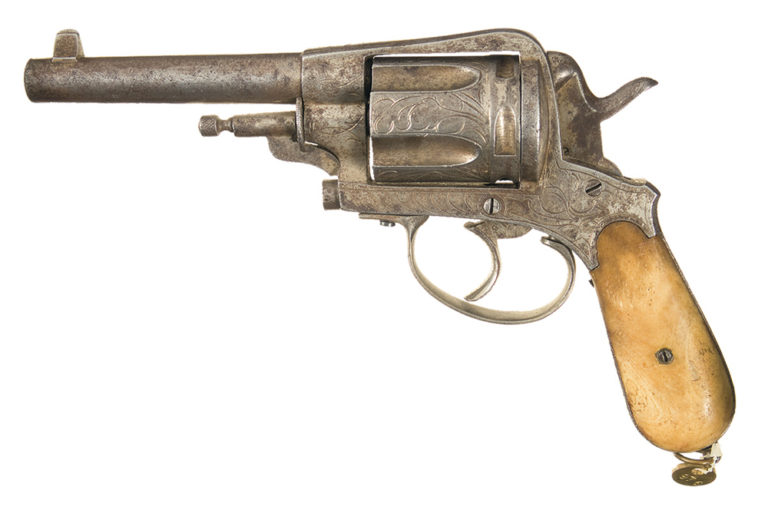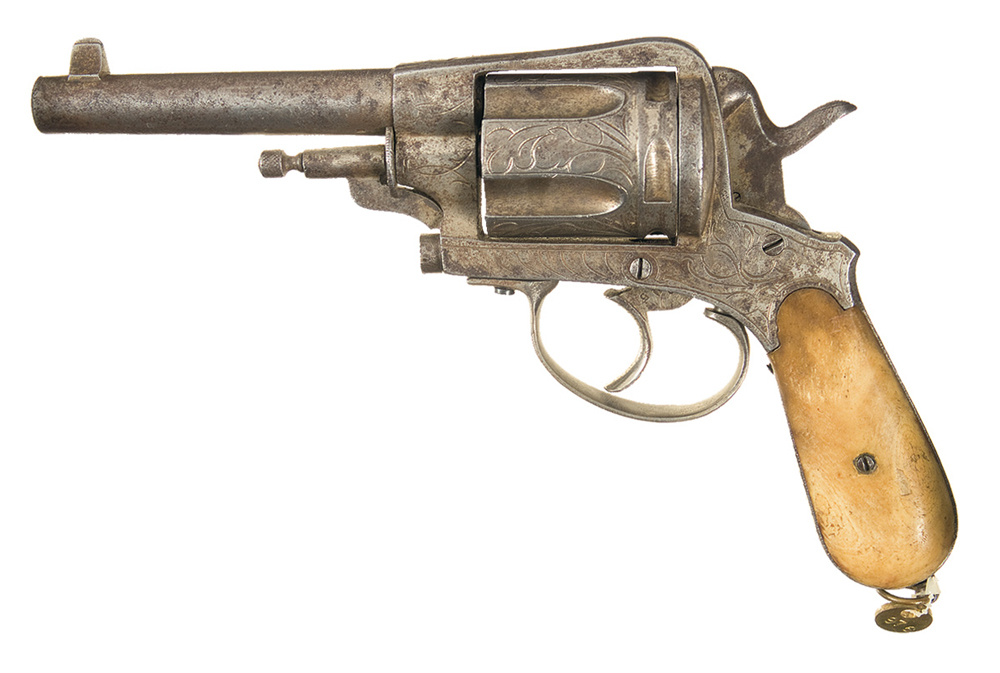
Montenegro is a small mountainous country of less than a half million people. It has a tumultuous history of wars and revolutions. The nation was independent from 1868 to 1920, when it was absorbed into Yugoslavia. When Yugoslavia broke up in a bloody civil war in the 1990s, Montenegro once again opted for self-rule. It is also the only nation that ever had its name become synonymous for a type of firearm. I speak today of the Montenegrin revolver.
What is a Montenegrin revolver? Basically it is a large-frame double action revolver chambered for the 11.25x36mm cartridge. These guns were made in Austria, Belgium and Spain. Oddly, none were made in Montenegro. The reason they became associated with Montenegro is that the king of that country ordered his citizens to own these revolvers. I think this is the only case in history where a national leader ordered the general population to arm themselves with a specific firearm.
“Every male citizen of Montenegro is a member of the Militia, and therefore not only justified but also obliged to possess at least one Gasser Pattern revolver.” That proclamation was issued by King Nicolas, who ruled Montenegro from 1910-1918. The Gasser Pattern revolver he was talking about was the Austrian Gasser Model 1870 revolver. This was the issued sidearm of Austria from 1870-1878. When they were replaced by the Gasser M1878, some of the earlier 1870s were sold to Montenegro. These became very popular with the military officers.
After Nicolas was made King by the Montenegrin parliament in 1910 he tried to unite his small kingdom into a formidable foe that would strike fear in hostile neighbors like Albania or Austria. Among his many reforms was the proclamation ordering revolver ownership by the male population. It is rumored that King Nicolas held stock in the Leopold Gasser company and made a bit of money off his order. Production of the Montenegrin revolvers helped keep the Austrian arms maker in business through the end of WWI. Of course, such things were not as controversial then as they would be today.
With the huge demand for new Gasser revolvers other makers jumped in to the market. Most were in Belgium and Spain. Both nations were home to cottage gun industries that turned out all kinds of guns. Quality ran from excellent to dangerous. Some of the manufacturers deviated from the Gasser design. There were solid-frame and hinged-frame designs; long and short barrels. The things that identify a Montenegrin revolver are the huge cylinder that accommodates 11.25x36mm ammunition and the rounded handle that resembles that found on the Mauser Model 1896 “Broomhandle” pistol.
The 11.25x36mm cartridge is much longer than a .44 Magnum. It was loaded with black powder and fired a 310-grain bullet at almost 900 feet per second. It was the ‘Magnum” of the era, more powerful than contemporaries like the .45 Colt and .44 Russian. I made a dummy cartridge out of a Danish Remington rolling block cartridge, just to see what they looked like next to a .44 Magnum. I would never attempt to fire any of the Belgian or Spanish Montenegrin revolvers. I might be tempted to try a Gasser-made specimen, if it was in good condition.
The revolvers became status symbols among the Montenegrin population. The men would wear one or more hanging out of their traditional attire like some sort of early 20th Century bling-bling. The revolvers were offered with ivory or bone grips, nickel plating and engraving. The well off bought the Gasser-made guns while the common folk settled for the less costly Belgian or Spanish examples.
I recently examined a pair of the Belgian-made Montenegrin revolvers at a local gun show. Both guns were of the same design. There are no clear maker’s names, only Belgian proof marks on the cylinders. One is marked on top of the barrel “Vero Revolver Montengrino.” Both are marked “Cuss Stahl” which means cast steel. That, in my opinion, would not be the best material from which to make a firearm. Cast parts can have unseen faults that make themselves known only when the gun blows the top off a chamber or splits the barrel.
Many Montenegrin revolvers found their way to North America in the luggage of immigrants from Montenegro. They were considered an essential part of life in the old country so of course their owners took them along to the new country. Once here, the old rivals were spread out so they rarely came in contact with each other. Within a couple generations, the reasons and perceived need for the revolvers faded. And the status gained from wearing a revolver was lost in many parts of America. The revolvers ended up being given away or sold. If you look for them, you can find Montenegrin revolvers at gun shows and online. They are interesting collectibles, but don’t plan on taking them to the range.
This article appeared in the July 18, 2011 issue of Gun Digest the Magazine.

Next Step: Get your FREE Printable Target Pack
Enhance your shooting precision with our 62 MOA Targets, perfect for rifles and handguns. Crafted in collaboration with Storm Tactical for accuracy and versatility.
Subscribe to the Gun Digest email newsletter and get your downloadable target pack sent straight to your inbox. Stay updated with the latest firearms info in the industry.


![Best Concealed Carry Guns In 2025 [Field Tested] Wilson Combat EDC X9S 1](https://gundigest.com/wp-content/uploads/Wilson-Combat-EDC-X9S-1-324x160.jpg)


![Best 9mm Carbine: Affordable PCCs [Tested] Ruger Carbine Shooting](https://gundigest.com/wp-content/uploads/Ruger-Carbine-Shooting-100x70.jpg)
![Best AR-15: Top Options Available Today [Field Tested] Harrington and Richardson PSA XM177E2 feature](https://gundigest.com/wp-content/uploads/Harrington-and-Richardson-PSA-XM177E2-feature-100x70.jpg)

Have any information on the Pfeifer Zeliska .600 Nitro Express Revolver. I ran across a blurb about it online, but can’t find a manufacturer. Is it a hoax? If not, have they ever been imported into the US?